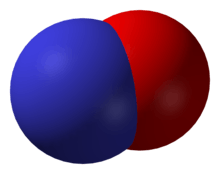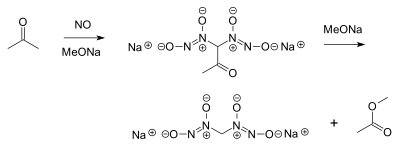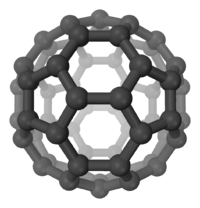Nitric oxide
Nitric oxide (nitrogen oxide[3] or nitrogen monoxide) is a colorless gas with the formula NO. It is one of the principal oxides of nitrogen. Nitric oxide is a free radical, i.e., it has an unpaired electron, which is sometimes denoted by a dot in its chemical formula (·N=O or ·NO). Nitric oxide is also a heteronuclear diatomic molecule, a historic class that drew researches which spawned early modern theories of chemical bonding.[4]
 | |||
| |||
| Names | |||
|---|---|---|---|
| IUPAC name
Nitrogen monoxide | |||
| Systematic IUPAC name
Oxidonitrogen(•)[1] (additive) | |||
| Other names
Nitric oxide Nitrogen(II) oxide | |||
| Identifiers | |||
3D model (JSmol) |
|||
| 3DMet | |||
| ChEBI | |||
| ChEMBL | |||
| ChemSpider | |||
| DrugBank | |||
| ECHA InfoCard | 100.030.233 | ||
| EC Number |
| ||
| 451 | |||
| KEGG | |||
PubChem CID |
|||
| RTECS number |
| ||
| UNII | |||
| UN number | 1660 | ||
CompTox Dashboard (EPA) |
|||
| |||
| |||
| Properties | |||
| NO | |||
| Molar mass | 30.006 g·mol−1 | ||
| Appearance | Colourless gas | ||
| Density | 1.3402 g/L | ||
| Melting point | −164 °C (−263 °F; 109 K) | ||
| Boiling point | −152 °C (−242 °F; 121 K) | ||
| 0.0098 g / 100 ml (0 °C) 0.0056 g / 100 ml (20 °C) | |||
Refractive index (nD) |
1.0002697 | ||
| Structure | |||
| linear (point group C∞v) | |||
| Thermochemistry | |||
Std molar entropy (S |
210.76 J/(K·mol) | ||
Std enthalpy of formation (ΔfH⦵298) |
91.29 kJ/mol | ||
| Pharmacology | |||
| R07AX01 (WHO) | |||
| License data | |||
| Inhalation | |||
| Pharmacokinetics: | |||
| good | |||
| via pulmonary capillary bed | |||
| 2–6 seconds | |||
| Hazards | |||
| Safety data sheet | External MSDS | ||
EU classification (DSD) (outdated) |
|||
| R-phrases (outdated) | R8, R23, R34, R44 | ||
| S-phrases (outdated) | (S1), S17, S23, S36/37/39, S45 | ||
| NFPA 704 (fire diamond) | |||
| Lethal dose or concentration (LD, LC): | |||
LC50 (median concentration) |
315 ppm (rabbit, 15 min) 854 ppm (rat, 4 h) 2500 ppm (mouse, 12 min)[2] | ||
LCLo (lowest published) |
320 ppm (mouse)[2] | ||
| Related compounds | |||
| Dinitrogen pentoxide Dinitrogen tetroxide | |||
Except where otherwise noted, data are given for materials in their standard state (at 25 °C [77 °F], 100 kPa). | |||
| Infobox references | |||
An important intermediate in industrial chemistry, nitric oxide forms in combustion systems and can be generated by lightning in thunderstorms. In mammals, including humans, nitric oxide is a signaling molecule in many physiological and pathological processes.[5] It was proclaimed the "Molecule of the Year" in 1992.[6] The 1998 Nobel Prize in Physiology or Medicine was awarded for discovering nitric oxide's role as a cardiovascular signalling molecule.
Nitric oxide should not be confused with nitrogen dioxide (NO2), a brown gas and major air pollutant, or with nitrous oxide (N2O), an anesthetic.[4]
Reactions
With di- and triatomic molecules
Upon condensing to a liquid, nitric oxide dimerizes to dinitrogen dioxide, but the association is weak and reversible. The N–N distance in crystalline NO is 218 pm, nearly twice the N–O distance.[4]
Since the heat of formation of ·NO is endothermic, NO can be decomposed to the elements. Catalytic converters in cars exploit this reaction:
- 2 NO → O2 + N2.
When exposed to oxygen, nitric oxide converts into nitrogen dioxide:
- 2 NO + O2 → 2 NO2.
This conversion has been speculated as occurring via the ONOONO intermediate.
In water, nitric oxide reacts with oxygen and water to form nitrous acid (HNO2). The reaction is thought to proceed via the following stoichiometry:
- 4 NO + O2 + 2 H2O → 4 HNO2.
Nitric oxide reacts with fluorine, chlorine, and bromine to form the nitrosyl halides, such as nitrosyl chloride:
- 2 NO + Cl2 → 2 NOCl.
With NO2, also a radical, NO combines to form the intensely blue dinitrogen trioxide:[4]
- NO + NO2 ⇌ ON−NO2.
Organic chemistry
The addition of a nitric oxide moiety to another molecule is often referred to as nitrosylation. Nitric oxide reacts with acetone and an alkoxide to a diazeniumdiolate or nitrosohydroxylamine and methyl acetate:[7]
This reaction, which was discovered around 1898, remains of interest in nitric oxide prodrug research. Nitric oxide can also react directly with sodium methoxide, forming sodium formate and nitrous oxide.[8]
Coordination complexes
Nitric oxide reacts with transition metals to give complexes called metal nitrosyls. The most common bonding mode of nitric oxide is the terminal linear type (M−NO).[4] Alternatively, nitric oxide can serve as a one-electron pseudohalide. In such complexes, the M−N−O group is characterized by an angle between 120° and 140°. The NO group can also bridge between metal centers through the nitrogen atom in a variety of geometries.
Production and preparation
In commercial settings, nitric oxide is produced by the oxidation of ammonia at 750–900 °C (normally at 850 °C) with platinum as catalyst in the Ostwald process:
- 4 NH3 + 5 O2 → 4 NO + 6 H2O
The uncatalyzed endothermic reaction of oxygen (O2) and nitrogen (N2), which is effected at high temperature (>2000 °C) by lightning has not been developed into a practical commercial synthesis (see Birkeland–Eyde process):
- N2 + O2 → 2 NO
Laboratory methods
In the laboratory, nitric oxide is conveniently generated by reduction of dilute nitric acid with copper:
- 8 HNO3 + 3 Cu → 3 Cu(NO3)2 + 4 H2O + 2 NO
An alternative route involves the reduction of nitrous acid in the form of sodium nitrite or potassium nitrite:
- 2 NaNO2 + 2 NaI + 2 H2SO4 → I2 + 2 Na2SO4 + 2 H2O + 2 NO
- 2 NaNO2 + 2 FeSO4 + 3 H2SO4 → Fe2(SO4)3 + 2 NaHSO4 + 2 H2O + 2 NO
- 3 KNO2 + KNO3 + Cr2O3 → 2 K2CrO4 + 4 NO
The iron(II) sulfate route is simple and has been used in undergraduate laboratory experiments. So-called NONOate compounds are also used for nitric oxide generation.
Detection and assay
_(white)_in_the_cytoplasm_(green)_of_clusters_of_conifer_cells_one_hour_after_mechanical_agitation.jpg)
Nitric oxide concentration can be determined using a chemiluminescent reaction involving ozone.[9] A sample containing nitric oxide is mixed with a large quantity of ozone. The nitric oxide reacts with the ozone to produce oxygen and nitrogen dioxide, accompanied with emission of light (chemiluminescence):
- NO + O3 → NO2 + O2 + hν
which can be measured with a photodetector. The amount of light produced is proportional to the amount of nitric oxide in the sample.
Other methods of testing include electroanalysis (amperometric approach), where ·NO reacts with an electrode to induce a current or voltage change. The detection of NO radicals in biological tissues is particularly difficult due to the short lifetime and concentration of these radicals in tissues. One of the few practical methods is spin trapping of nitric oxide with iron-dithiocarbamate complexes and subsequent detection of the mono-nitrosyl-iron complex with electron paramagnetic resonance (EPR).[10][11]
A group of fluorescent dye indicators that are also available in acetylated form for intracellular measurements exist. The most common compound is 4,5-diaminofluorescein (DAF-2).[12]
Environmental effects
Acid rain deposition
Nitric oxide reacts with the hydroperoxy radical (HO2•) to form nitrogen dioxide (NO2), which then can react with a hydroxyl radical (•OH) to produce nitric acid (HNO3):
- ·NO + HO2•→ •NO2 + •OH
- ·NO2 + •OH → HNO3
Nitric acid, along with sulfuric acid, contributes to acid rain deposition.
Ozone depletion
·NO participates in ozone layer depletion. Nitric oxide reacts with stratospheric ozone to form O2 and nitrogen dioxide:
- ·NO + O3 → NO2 + O2
This reaction is also utilized to measure concentrations of ·NO in control volumes.
Precursor to NO2
As seen in the Acid deposition section, nitric oxide can transform into nitrogen dioxide (this can happen with the hydroperoxy radical, HO2•, or diatomic oxygen, O2). Symptoms of short-term nitrogen dioxide exposure include nausea, dyspnea and headache. Long-term effects could include impaired immune and respiratory function.[13]
Biological functions
NO is a gaseous signaling molecule.[14] It is a key vertebrate biological messenger, playing a role in a variety of biological processes.[15] It is a known bioproduct in almost all types of organisms, ranging from bacteria to plants, fungi, and animal cells.[16]
Nitric oxide, known as an endothelium-derived relaxing factor (EDRF), is biosynthesized endogenously from L-arginine, oxygen, and NADPH by various nitric oxide synthase (NOS) enzymes.[17] Reduction of inorganic nitrate may also serve to make nitric oxide.[18] One of the main enzymatic targets of nitric oxide is guanylyl cyclase.[19] The binding of nitric oxide to the haem region of the enzyme leads to activation, in the presence of iron.[19] Nitric oxide is highly reactive (having a lifetime of a few seconds), yet diffuses freely across membranes. These attributes make nitric oxide ideal for a transient paracrine (between adjacent cells) and autocrine (within a single cell) signaling molecule.[18] Once nitric oxide is converted to nitrates and nitrites by oxygen and water, cell signaling is deactivated.[19]
The endothelium (inner lining) of blood vessels uses nitric oxide to signal the surrounding smooth muscle to relax, thus resulting in vasodilation and increasing blood flow.[18] Sildenafil (Viagra) is a common example of a drug that uses the nitric oxide pathway. Sildenafil does not produce nitric oxide, but enhances the signals that are the downstream of the nitric oxide pathway by protecting cyclic guanosine monophosphate (cGMP) from degradation by cGMP-specific phosphodiesterase type 5 (PDE5) in the corpus cavernosum, allowing for the signal to be enhanced, and thus vasodilation.[17] Another endogenous gaseous transmitter, hydrogen sulfide (H2S) works with NO to induce vasodilatation and angiogenesis in a cooperative manner.[20][21][21]
Occupational safety and health
In the U.S., the Occupational Safety and Health Administration (OSHA) has set the legal limit (permissible exposure limit) for nitric oxide exposure in the workplace as 25 ppm (30 mg/m3) over an 8-hour workday. The National Institute for Occupational Safety and Health (NIOSH) has set a recommended exposure limit (REL) of 25 ppm (30 mg/m3) over an 8-hour workday. At levels of 100 ppm, nitric oxide is immediately dangerous to life and health.[22]
References
- "Nitric Oxide (CHEBI:16480)". Chemical Entities of Biological Interest (ChEBI). UK: European Bioinformatics Institute.
- "Nitric oxide". Immediately Dangerous to Life and Health Concentrations (IDLH). National Institute for Occupational Safety and Health (NIOSH).
- IUPAC nomenclature of inorganic chemistry 2005. PDF.
- Greenwood, Norman N.; Earnshaw, Alan (1997). Chemistry of the Elements (2nd ed.). Butterworth-Heinemann. ISBN 978-0-08-037941-8.
- Hou, Y. C.; Janczuk, A.; Wang, P. G. (1999). "Current trends in the development of nitric oxide donors". Current Pharmaceutical Design. 5 (6): 417–441. PMID 10390607.
- Culotta, Elizabeth; Koshland, Daniel E. Jr. (1992). "NO news is good news". Science. 258 (5090): 1862–1864. Bibcode:1992Sci...258.1862C. doi:10.1126/science.1361684. PMID 1361684.
- Traube, Wilhelm (1898). "Ueber Synthesen stickstoffhaltiger Verbindungen mit Hülfe des Stickoxyds". Justus Liebig's Annalen der Chemie (in German). 300: 81–128. doi:10.1002/jlac.18983000108.
- Derosa, Frank; Keefer, Larry K.; Hrabie, Joseph A. (2008). "Nitric Oxide Reacts with Methoxide". The Journal of Organic Chemistry. 73 (3): 1139–42. doi:10.1021/jo7020423. PMID 18184006.
- Fontijn, Arthur.; Sabadell, Alberto J.; Ronco, Richard J. (1970). "Homogeneous chemiluminescent measurement of nitric oxide with ozone. Implications for continuous selective monitoring of gaseous air pollutants". Analytical Chemistry. 42 (6): 575–579. doi:10.1021/ac60288a034.
- Vanin, A; Huisman, A; Van Faassen, E (2002). Iron dithiocarbamate as spin trap for nitric oxide detection: Pitfalls and successes. Methods in Enzymology. 359. pp. 27–42. doi:10.1016/S0076-6879(02)59169-2. ISBN 9780121822620. PMID 12481557.
- Nagano, T; Yoshimura, T (2002). "Bioimaging of nitric oxide". Chemical Reviews. 102 (4): 1235–70. doi:10.1021/cr010152s. PMID 11942795.
- Kojima H, Nakatsubo N, Kikuchi K, Kawahara S, Kirino Y, Nagoshi H, Hirata Y, Nagano T (1998). "Detection and imaging of nitric oxide with novel fluorescent indicators: diaminofluoresceins". Anal. Chem. 70 (13): 2446–2453. doi:10.1021/ac9801723. PMID 9666719.
- "Centers for Disease Control and Prevention". NIOSH. 1 July 2014. Retrieved 10 December 2015.
- Liu, Hongying; Weng, Lingyan; Yang, Chi (2017-03-28). "A review on nanomaterial-based electrochemical sensors for H2O2, H2S and NO inside cells or released by cells". Microchimica Acta. 184 (5): 1267–1283. doi:10.1007/s00604-017-2179-2. ISSN 0026-3672.
- Weller, Richard, Could the sun be good for your heart? TedxGlasgow. Filmed March 2012, posted January 2013
- Roszer, T (2012) The Biology of Subcellular Nitric Oxide. ISBN 978-94-007-2818-9
- Perez, Krystle M.; Laughon, Matthew (November 2015). "Sildenafil in Term and Premature Infants: A Systematic Review". Clinical Therapeutics. 37 (11): 2598–2607.e1. doi:10.1016/j.clinthera.2015.07.019. ISSN 0149-2918. PMID 26490498.
- Stryer, Lubert (1995). Biochemistry, 4th Edition. W.H. Freeman and Company. p. 732. ISBN 978-0-7167-2009-6.
- T., Hancock, John (2010). Cell signalling (3rd ed.). Oxford: Oxford University Press. ISBN 9780199232109. OCLC 444336556.
- Szabo, Csaba; Coletta, Ciro; Chao, Celia; Módis, Katalin; Szczesny, Bartosz; Papapetropoulos, Andreas; Hellmich, Mark R. (2013-07-23). "Tumor-derived hydrogen sulfide, produced by cystathionine-β-synthase, stimulates bioenergetics, cell proliferation, and angiogenesis in colon cancer". Proceedings of the National Academy of Sciences of the United States of America. 110 (30): 12474–12479. Bibcode:2013PNAS..11012474S. doi:10.1073/pnas.1306241110. ISSN 1091-6490. PMC 3725060. PMID 23836652.
- Altaany, Zaid; Yang, Guangdong; Wang, Rui (July 2013). "Crosstalk between hydrogen sulfide and nitric oxide in endothelial cells". Journal of Cellular and Molecular Medicine. 17 (7): 879–888. doi:10.1111/jcmm.12077. ISSN 1582-4934. PMC 3822893. PMID 23742697.
- "Nitric oxide". National Institute for Occupational Safety and Health. Retrieved 2015-11-20.
Further reading
- Butler A. and Nicholson R.; "Life, death and NO." Cambridge 2003. ISBN 978-0-85404-686-7.
- van Faassen, E. E.; Vanin, A. F. (eds); "Radicals for life: The various forms of Nitric Oxide." Elsevier, Amsterdam 2007. ISBN 978-0-444-52236-8.
- Ignarro, L. J. (ed.); "Nitric oxide:biology and pathobiology." Academic Press, San Diego 2000. ISBN 0-12-370420-0.
External links
- International Chemical Safety Card 1311
- "Nitric oxide and its role in health and diabetes".
- Microscale Gas Chemistry: Experiments with Nitrogen Oxides
- Your Brain Boots Up Like a Computer – new insights about the biological role of nitric oxide.
- Assessing The Potential of Nitric Oxide in the Diabetic Foot
- New Discoveries About Nitric Oxide Can Provide Drugs For Schizophrenia
- Nitric Oxide at the Chemical Database
- "Immediately Dangerous to Life or Health Concentrations (IDLH): Nitric oxide". National Institute for Occupational Safety and Health.




